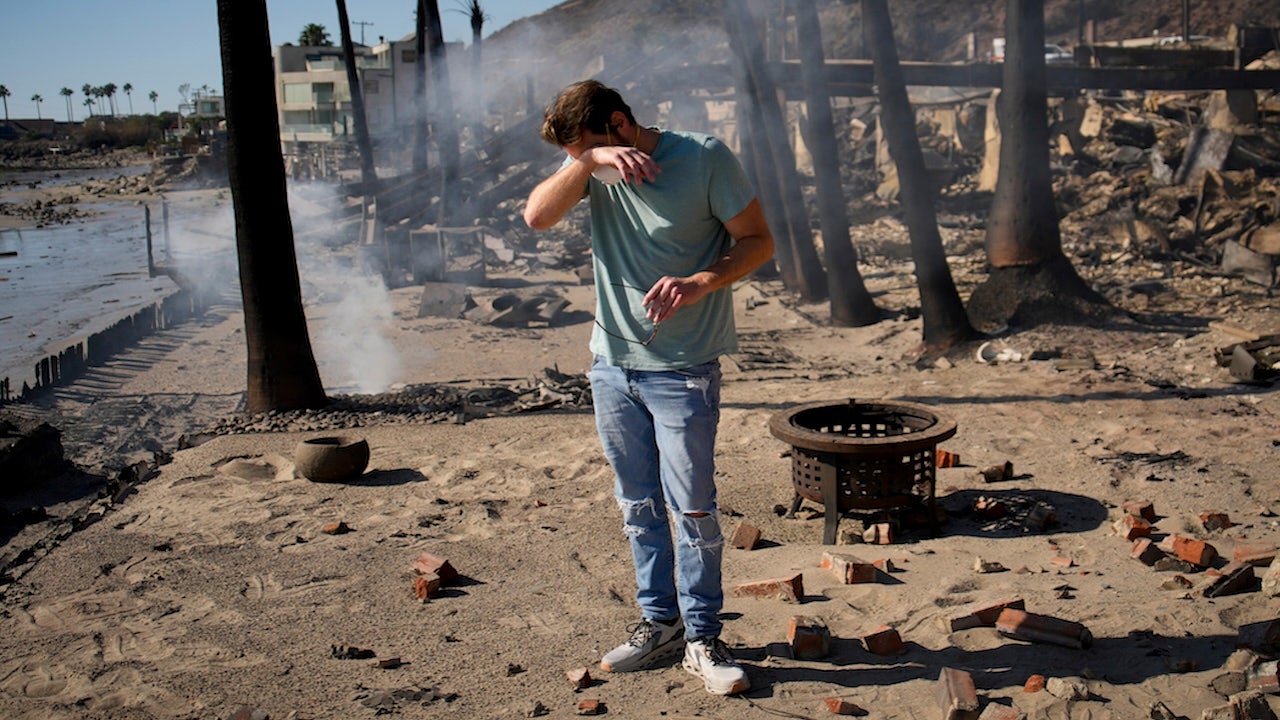Health
Father created a drug to save his son from a rare disease, now other families are desperate to get it

When his infant son was diagnosed with a rare, fatal disease, a Canadian father was dismayed to discover there was no treatment or cure. So he set out to make one himself.
Terry Pirovolakis, an IT director in Toronto, Ontario, welcomed his third son in Dec. 2017. It was a “normal, healthy birth,” he told Fox News Digital — but within six months, he and his wife, Georgia Pirovolakis, noticed their baby, Michael, was not lifting his head.
“He just didn’t seem like he was meeting his milestones,” Pirovolakis said.
MOTHER FRANTIC TO SAVE CLINICAL TRIAL THAT COULD CURE HER DAUGHTER: ‘THE TREATMENT IS SITTING IN A FRIDGE’
After months of doctors’ appointments, physiotherapy and genetic testing — what Pirovolakis describes as an “18-month diagnostic odyssey” — a neurologist diagnosed baby Michael with spastic paraplegia 50 (SPG50), a neurological disorder that affects fewer than 100 people in the world.
“They told us to just go home and love him — and said he would be paralyzed from the waist down by age 10, and quadriplegic by age 20,” Pirovolakis said.
When Michael Pirovolakis, pictured. was diagnosed with a rare, fatal disease as an infant, his father, Terry Pirovolakis, was dismayed to discover there was no treatment or cure. That’s when he set out to make one himself. (Terry Pirovolakis)
“They said he’d never walk or talk, and would need support for the rest of his life.”
What is SPG50?
Spastic paraplegia 50 (SPG50) is a neurological disorder that affects a child’s development, gradually leading to cognitive impairment, muscle weakness, speech impairment and paralysis, according to the National Organization for Rare Disorders.
Most people with the disease will die by the time they reach their 20s.
“Children with SPG50 may experience early developmental delays, muscle weakness and spasticity, but they continue to strive and adapt,” Dr. Eve Elizabeth Penney, an epidemiologist at the Texas Department of State Health Services and medical contributor for Drugwatch, told Fox News Digital.
WHAT IS ANGELMAN SYNDROME? COLIN FARRELL’S SON IS LIVING WITH THIS RARE DISEASE
“Over time, these symptoms can worsen, making it hard for affected individuals to walk and perform daily activities,” added Penney, who was not involved in Michael Pirovolakis’ care.
“The prognosis varies from person to person, but it’s generally a progressive condition, meaning symptoms can become more severe over time,” she also said.

Georgia Pirovolakis (left) is pictured with her two sons, including baby Michael, who was diagnosed with SPG50. (Terry Pirovolakis)
In the absence of a cure, most families can only manage symptoms through physical therapy, occupational therapy, speech therapy and medications to help control spasticity or seizures, Penney said.
“Managing SPG50 requires a comprehensive, multidisciplinary approach to address its various symptoms and challenges,” she added.
A father’s mission
There is no treatment currently approved by the U.S. Food and Drug Administration (FDA) for SPG50.
After the shock of the diagnosis, Pirovolakis immediately started researching, with a focus on finding a gene therapy that could help his son.
“They said he would be paralyzed from the waist down by age 10, and quadriplegic by age 20.”
A month after his baby’s diagnosis, Pirovolakis flew to Washington, D.C., for a gene therapy conference, where he met with several experts. He also visited Sheffield, England, and the National Institutes of Health at the University of Cambridge, where scientists had been studying the disease.
“We then liquidated our life savings, refinanced our home and paid a team at the University of Texas Southwestern Medical Center to create a proof of concept to start Michael’s gene therapy,” Pirovolakis said.

Terry Pirovolakis, pictured with his family, used his life savings to create a genetic therapy for his youngest son, center, who has SPG50. (Terry Pirovolakis)
After successful tests showed the gene therapy was effective at stopping the disease’s progression in mice and in human cells, Pirovolakis worked with a small drug company in Spain to manufacture the drug.
On Dec. 30, 2021, Health Canada granted approval to move forward with the gene therapy for Michael Pirovolakis.
STIFF PERSON SYNDROME PATIENTS SHARE WHAT IT’S LIKE TO LIVE WITH THE RARE DISEASE
“On March 24, 2022, my son was the first person to ever get treated with gene therapy at SickKids in Toronto,” Pirovolakis said.
The procedure, which involves injecting cerebral spinal fluid through a lumbar puncture, does come with risks — but the potential benefits are life-saving.
‘I couldn’t let them die’
After Michael Pirovolakis received the one-time treatment, there were three more doses left.
“We decided that we had to help other kids,” Pirovolakis said.
“When I heard that no one was going to do anything about it, I had to — I couldn’t let them die.”

Pirovolakis’ two older children, pictured with their little brother, Michael, bottom left, do not have the disease. (Terry Pirovolakis)
Pirovolakis opened up a Phase 2 study in the U.S., which treated three children two years ago.
One of those was 6-month-old Jack Lockard, the youngest child to ever receive the treatment.
“Jack has thrived since then,” Rebekah Lockard, the boy’s mother, told Fox News Digital.
THE GIRL WHO CAN’T SMILE: HOW A RARE DISORDER BECAME A YOUNG WOMAN’S ‘GREATEST GIFT’
“He is sitting independently, banging toys together, drinking from a straw cup and working really hard on crawling.”
She added, “Doctors and therapists share the same sentiment: The treatment works!”
Other children who participated in the trial have experienced similar results, Lockard said.

The Lockard family, shown here, is fighting to raise funds to obtain treatment for their daughter Naomi, at right, who has SPG50. (Rebekah Lockard)
“They’ve all shown that their disease has stopped progressing and their cognition has improved.”
There are more children who still need the treatment — including Lockard’s first child, 3-year-old Naomi, who also has SPG50 — but are unable to access it because the clinical trial has now run out of money, as Fox News Digital previously reported.
‘Time is of the essence’
It costs about $1 million to make the drug for each child, Pirovolakis said, and another $300,000 or so to treat the patient in the U.S. at the hospital.
Pirovolakis has approached pharmaceutical companies, but all of them have declined to manufacture the drug.
“We want to make sure the trial moves on and these kids get treated.”
“No investor is going to give you money to treat a disease that is not going to make money,” he said. “That’s the dilemma we’re in.”
While Pirovolakis and his team are actively working to secure grants and investors, it’s largely up to the parents to raise funds for the next phase of the clinical trial.

So far, Lockard has raised more than $90,000 via GoFundMe (called “Naomi and Jack Battle SPG50”) to get her daughter’s treatment, but that is only a fraction of what is needed. (Rebekah Lockard)
So far, Lockard has raised more than $90,000 via GoFundMe (called “Naomi and Jack Battle SPG50”) to get her daughter’s treatment, but that is only a fraction of what is needed.
Penney noted that treatment for SPG50 is challenging and expensive to develop — “mainly because it’s a sporadic disease.”
The doctor told Fox News Digital, “Pharmaceutical companies often prioritize conditions that affect larger populations, with a more significant potential for recouping research and development costs.”
CHILDREN WITH TOTAL DEAFNESS REGAIN HEARING AFTER ‘GROUNDBREAKING’ GENE THERAPY: ‘LIKE A MIRACLE’
“The market is much smaller for rare diseases like SPG50, making it financially less viable for companies to invest in creating a treatment.”
To devote himself to the cause, Pirovolakis quit his job and started a nonprofit in California, which now has five employees and 20 consultants.
The company — called Elpida Therapeutics, after the Greek word for “hope” — will run a Phase 3 study for SPG50 at the NIH in November.

Terry Pirovolakis, second from left, is pictured with members of his team at his nonprofit, Elpida Therapeutics. Elpida Therapeutics has partnered with the Columbus Children’s Foundation (Fundación Columbus in Spain) and CureSPG50 to help save children with the disease. (Pirovolakis)
Without the backing of major drug companies, however, there isn’t funding available to get the therapies to the children who need them.
Eight doses of the drug for SPG50 were produced in Spain and have been flown to the U.S.
“The treatment is here, just literally sitting in a refrigerator, ready to go,” Lockard said. “Doctors are ready. There just isn’t enough money to make it happen.”
For more Health articles, visit www.foxnews.com/health
There are currently four families in the U.S. who are trying to raise the money that’s needed, according to Pirovolakis.
“Time is of the essence,” he said. “We want to make sure the trial moves on and these kids get treated.”
The end goal
Looking ahead to the Phase 3 clinical trial at the NIH, Pirovolakis’ goal is to treat eight children with SPG50.
“If we can show that it works in all eight children — and we can prove to the FDA that it is making a difference — then the drug will get approved and every child can get it,” he said.

Michael Pirovolakis is pictured walking with the aid of a walker. Spastic paraplegia 50 (SPG50) is a neurological disorder that affects a child’s development, gradually leading to cognitive impairment, muscle weakness, speech impairment and paralysis. (Terry Pirovolakis)
Ideally, after the drug is approved — which could take three to five years, Pirovolakis estimates — SPG50 will be added to hospitals’ newborn screening programs and every child with the disease will be able to get the therapy.
Elpida Therapeutics has partnered with the Columbus Children’s Foundation (Fundación Columbus in Spain) and CureSPG50 to help save children with the disease.
“Our partnership with Elpida is driven by an unwavering commitment to leaving no child behind,” Sheila Mikhail, co-founder of the CCF, said in a statement to Fox News Digital.
“At the Columbus Children’s Foundation and Fundacion Columbus, as a global organization, we believe that every child deserves a chance for a healthy future. Together, we’re making groundbreaking strides in treating ultra-rare genetic disorders, ensuring that no child is left to face these challenges alone.”
“The biggest challenge in providing treatment for children with rare diseases often comes down to a lack of funding and vision.”
Pirovolakis said he gets several calls each week from families around the world, asking for help saving their children.
“Unfortunately, the biggest challenge in providing treatment for children with rare diseases often comes down to a lack of funding and vision,” he told Fox News Digital.

After Jack Lockard, pictured, received the gene therapy at 6 months old, the family soon noticed improvements in his cognitive and physical milestones. (Rebekah Lockard)
“The technology to cure our children is already here. I hope that someone with immense wealth — and more importantly, the vision and influence — will step in,” he said.
“Their support could not only impact a handful of diseases and children, but extend hope to thousands of rare diseases and millions of children, both this generation and the next.”
CLICK HERE TO SIGN UP FOR OUR HEALTH NEWSLETTER
Currently, 40 million Americans are living with a rare disease, and one in 10 will be afflicted by a potentially treatable rare condition.
Pirovolakis added, “Someone you know or love will likely be affected by a rare disease.”

Health
Deep sleep can keep two big health problems at bay, new studies suggest

It might be worth working a little bit harder to get that much-desired, but often elusive, good night’s sleep.
Deep sleep clears the mind of waste just as a “dishwasher” cleans dirty plates and glasses, just-published research suggests — and there’s more.
The findings also offer insights into how sleeping pills may disrupt the “brainwashing” system — potentially affecting cognitive function for people over the long run.
ANOTHER REASON TO GET MORE SLEEP AND THIS ONE MIGHT SURPRISE YOU
Study senior author professor Maiken Nedergaard of the University of Rochester and the University of Copenhagen said norepinephrine (a neurotransmitter and hormone) triggers blood vessels to contract — generating slow pulsations that create a rhythmic flow in the surrounding fluid to carry away waste, news agency SWNS noted.
Said Nedergaard, “It’s like turning on the dishwasher before you go to bed and waking up with a clean brain. . . . We’re essentially asking what drives this process and trying to define restorative sleep based on” this “glymphatic clearance.”
“It’s like turning on the dishwasher before you go to bed and waking up with a clean brain.” (iStock)
The brain has a built-in waste removal process – the glymphatic system – that circulates fluid in the brain and spinal cord to clear out waste, according to the scientists.
The process helps remove toxic proteins that form sticky plaques linked to neurological disorders, such as Alzheimer’s disease.
But the scientists indicated that what drives the system was unclear until now, according to the study.
Is all sleep created equal? The researchers wanted to find out.
To find clues, Nedergaard and her team looked into what happens in mice when their brains sleep, as SWNS reported of the study. The team focused on the relationship between norepinephrine and blood flow during deep sleep.
TRUMP’S DAYLIGHT SAVING PLAN AND SLEEP: WHAT YOU MUST KNOW
They found that norepinephrine waves correlate to variations in brain blood volume — suggesting that norepinephrine triggers a rhythmic pulsation in the blood vessels. The researchers then compared the changes in blood volume to brain fluid flow.
The brain fluid flow fluctuates in correspondence to blood volume changes, suggesting the vessels act as pumps to propel the surrounding brain fluid to flush out waste.

During deep sleep, toxic proteins that form sticky plaques linked to neurological disorders such as Alzheimer’s disease are removed, scientists say in a new study. (iStock)
Natalie Hauglund of the University of Copenhagen and the University of Oxford, the study’s lead author, said, “You can view norepinephrine as [the] conductor of an orchestra.”
She added, “There’s a harmony in the constriction and dilation of the arteries, which then drives the cerebrospinal fluid through the brain to remove the waste products.”
‘I CAN’T SLEEP BECAUSE OF RACING THOUGHTS AT NIGHT — HOW CAN I STOP THEM?’: ASK A DOCTOR
Hauglund said she wanted to understand whether all sleep is created equal.
To find out, the research team administered zolpidem, a common drug to aid sleep, to mice.
“If people aren’t getting the full benefits of sleep, they should be aware of that, so they can make informed decisions.”
They found that the norepinephrine waves during deep sleep were 50% lower in zolpidem-treated mice than in naturally sleeping mice.
Although the zolpidem-treated mice fell asleep more quickly — fluid transport into the brain dropped more than 30%, as SWNS reported.

Two new studies indicate the importance of getting a good night’s sleep — with one study saying a lack of sleep may be sabotaging the brain’s ability to keep intrusive thoughts at bay. (iStock)
The researchers say their findings, published in the journal Cell, suggest that the sleeping aid may disrupt the norepinephrine-driven waste clearance during sleep.
Hauglund said, “More and more people are using sleep medication, and it’s really important to know if that’s healthy sleep. If people aren’t getting the full benefits of sleep, they should be aware of that, so they can make informed decisions.”
CLICK HERE TO SIGN UP FOR OUR HEALTH NEWSLETTER
The research team said the findings likely apply to humans, who also have a glymphatic system, although it requires further testing.
Nedergaard added, “Now we know norepinephrine is driving the cleaning of the brain, we may figure out how to get people a long and restorative sleep.”
For more Health articles, visit www.foxnews.com/health
Meanwhile, a lack of sleep may be doing more damage than just making people groggy.
It could be sabotaging the brain’s ability to keep intrusive thoughts at bay.

Anyone who suffers from sleep deprivation may find that the brain’s defense against unwanted memories is weakened, say experts. (iStock)
Another new study, this one published in the Proceedings of the National Academy of Sciences, found that sleep deprivation weakens the brain’s defense against unwanted memories, allowing them to flood the mind, according to the New York Post.
“We show that sleep deprivation disrupts prefrontal inhibition of memory retrieval, and that the overnight restoration of this inhibitory mechanism is associated with time spent in rapid eye movement (REM) sleep,” the scientists said.
Health
How Kathy Bates Lost 100 Lbs—Plus Her Tips for Sustainable Weight Loss

Sign Up
Create a free account to access exclusive content, play games, solve puzzles, test your pop-culture knowledge and receive special offers.
Already have an account? Login
Use left and right arrow keys to navigate between menu items.
Use escape to exit the menu.
Health
California fires and mental health toll: Celebrities and therapists offer tips

As Los Angeles battles the worst wildfires in the city’s history, thousands of people have been displaced or have seen their homes burn to the ground.
Around 130,000 people were ordered to evacuate and some 10,000 structures were destroyed, according to the Associated Press. At least 10 people have died as a result of the blazes.
The devastation of the fires has undoubtedly taken a grave toll on the psyches of those affected, experts agree.
STEVE GUTTENBERG CALLS LA WILDFIRES ‘GREAT EQUALIZER,’ URGES PEOPLE TO LEAN ON ONE ANOTHER
Fox News Digital spoke with celebrities and mental health experts, who offered the following guidance for the people impacted.
Recognize your feelings
For those who have experienced a loss from the fires, common reactions include shock, disbelief and confusion, according to David Kessler, a grief counselor in Los Angeles and founder of Grief.com.
“I call it grief brain,” he told Fox News Digital.
Luke Dexter reacts as he sifts through the remains of his father’s fire-ravaged beachfront property in the aftermath of the Palisades Fire on Jan. 10, 2025 in Malibu, Calif. (AP Photo/John Locher) (AP Newsroom)
“Your mind is trying to comprehend what happened, and it’s a hard thing for it to do, because this is unimaginable that your house, your safety, is suddenly gone.”
Not all grief is related to death, Kessler noted, as there are many different types of losses.
“I always say grief is a change you didn’t want — and certainly a fire is a change we didn’t want,” he added.
WHAT IS PTSD? SYMPTOMS THAT CAN EMERGE AFTER EXPERIENCING A TRAUMATIC EVENT
It’s important to “self-validate” the reality of the loss, he said.
“People might give you toxic positivity of, ‘well, at least no one died,’” he said. “And while that’s true, the reality is you still have lost your home. Don’t let anyone minimize that.”
“The loss of a home is devastating and it can take years to recover.”
“I think we’re going to deal with a lot of depression after this, a lot of sadness.”
Actor Steve Guttenberg, who lives in Pacific Palisades, California, where fires erupted on Tuesday, shared how the disaster has impacted his own mental health.
“I’ve seen so much tragedy the last three or four days that I’ve got to be careful to … keep a hold of my mind,” he said in an interview with Fox News Digital.
“And I think that we’re going to deal with a lot of depression after this, a lot of sadness. And it’s going to be really tough because this is like nothing you’ve ever seen.”

Actor Steve Guttenberg, who lives in Pacific Palisades, California, where fires erupted on Tuesday, shared how the disaster has impacted his own mental health. (AGUSTIN PAULLIER/AFP via Getty Images; Fox News)
Gutenberg noted that while it’s “very normal” to be down, he is trying not to let himself “go down that hole.”
“But I’m pretty sad about this,” he added.
HOW TO COPE WITH ‘COLLECTIVE GRIEF’ WHEN MASS TRAGEDY STRIKES
Jonathan Alpert, a psychotherapist in Manhattan and Washington, D.C., noted that the grief following the Los Angeles fires is “profound.”
“It’s not just about the physical loss of homes or belongings — it’s also about the sense of safety and normalcy that has been lost,” he told Fox News Digital.
“It’s important for people to feel emotions and not ignore them. This is a normal reaction to such overwhelming loss and tragedy.”
Reach out for support
Guttenberg emphasized the importance of maintaining connections with others and drawing support from the community during a disaster of this magnitude.
“We’re social animals — we need people,” he said. “So I’m reaching out to my friends. There’s no way to meet right now because it’s so dangerous — so the best thing you cn do … is call and reach out and maybe you can drive somewhere.”

Experts agreed that it’s essential to avoid isolating yourself after a loss. “We need to be taken care of. We need other people around us.” (AP Newsroom)
Most of the people in town have evacuated, he pointed out. “There’s probably 10% of the population left here. Or less.”
Kessler reiterated that connection is critical after this type of trauma. “We need to be taken care of. We need other people around us. People equal safety,” he said.
“We need other people around us. People equal safety.”
Pastor Jesse Bradley of Grace Community Church outside Seattle, Washington, agreed that it’s essential to avoid isolating yourself after a loss.
“We need God and we need each other. Community is vital,” he told Fox News Digital.
“Family, friends and neighbors care about you. God sends His love through these people. Reject isolation. Don’t shut down and don’t shut people out.”
Take action
“In times of crisis such as this, regaining even small amounts of control can be grounding,” Alpert said.
He recommends creating a plan for what’s next, whether it’s finding temporary housing, accessing local resources or starting the process of rebuilding.
“Taking action — no matter how small — can help you move forward.”

Ben Treger hugs his wife Sarah Treger after finding his grandfather’s watches at the remains of their Pacific Palisades home on Thursday, Jan. 9, 2025. “If you do have survivor’s guilt, I always say the best thing is to take action,” one expert advised. (Juan Carlo/Imagn)
Kessler agreed, noting that people who are in the area but did not experience loss may feel a sense of relief mixed with guilt.
“If you do have survivor’s guilt, I always say the best thing is to take action,” he advised.
In the longer term, advocacy efforts can be a powerful tool in dealing with trauma, Alpert noted.
MIKE POSNER REVEALS HOW FAITH REDIRECTED HIS LIFE, OFFERS ADVICE ON SPENDING HOLIDAYS WITH FAMILY
“Working to improve fire prevention policies, supporting relief efforts or helping neighbors rebuild can provide a sense of purpose and empowerment during this difficult time,” he said.
Some people may be angry about the systems that failed to prevent the fires in the first place, Alpert acknowledged, and this anger can be a “powerful motivator.”
“Taking action — no matter how small — can help you move forward.”
“Use that energy to demand better, but don’t get stuck on the anger,” he advised.
“By holding leaders accountable for the policies — or lack thereof — that contributed to this devastation, and by asking the right questions and demanding answers, you might start to feel better.”
Seek professional help as needed
“The L.A. fires no doubt will not just leave physical scars, but deep emotional ones, too,” Alpert said.
“For many people, the fear, panic and helplessness experienced during the fires don’t just disappear — they linger, creating flashbacks, anxiety and difficulty functioning.”

“For many people, the fear, panic and helplessness experienced during the fires don’t just disappear — they linger, creating flashbacks, anxiety and difficulty functioning.” (iStock)
In many cases, this can lead to post-traumatic stress disorder (PTSD). Symptoms of this condition can include vivid memories of the fires, nightmares, hypervigilance or avoidance of anything that reminds someone of the event, Alpert said.
“It’s important to see this not as weakness, but rather, the mind’s and body’s way of trying to cope with extreme stress.”
“While the fires were devastating, they don’t diminish your strength or character.”
As you seek help, it’s also important to understand that PTSD doesn’t define you, he added.
“It’s a part of your experience, not your identity. While the fires were devastating, they didn’t diminish your strength or character.”
Lean on your faith
For those who have experienced traumatic grief, Kessler emphasized the importance of faith and spirituality.
CLICK HERE TO SIGN UP FOR OUR HEALTH NEWSLETTER
“They help ground us in a world full of fear,” he said. “And when we’ve lost everything, it can feel like our faith is the one thing we have to hold onto.”
During a time of crisis, Guttenberg said it’s important to “rely on anything that you believe in.”

Cesar Plaza becomes emotional while looking at his home destroyed by the Eaton Fire in Altadena, California, on Jan. 9, 2025. “It’s easy to be consumed with what you no longer have,” a pastor told Fox News Digital. (AP Photo/Nic Coury) (AP Newsroom)
“If you believe in your mom and dad, you rely on them, your brothers and sisters, your friends, your family. God, the universe.”
Above all, he added, “Just remember, you’re not alone. God is always with you. Jesus is always with you. You’ve got to hang on to that.”
Find ways to exercise gratitude
During times of hardship, it’s important to recognize the good things that are still in your life, Pastor Bradley said.
“It’s easy to be consumed with what you no longer have,” he told Fox News Digital.
For more Health articles, visit www.foxnews.com/health
“You need to be intentional to take inventory of the blessings in your life. For example, you might lose a home or business, but you still have family.”
This mindset will help you keep a healthy perspective and protect gratitude, Bradley added.
-

 Politics1 week ago
Politics1 week agoNew Orleans attacker had 'remote detonator' for explosives in French Quarter, Biden says
-

 Politics1 week ago
Politics1 week agoCarter's judicial picks reshaped the federal bench across the country
-

 Politics1 week ago
Politics1 week agoWho Are the Recipients of the Presidential Medal of Freedom?
-

 Health6 days ago
Health6 days agoOzempic ‘microdosing’ is the new weight-loss trend: Should you try it?
-

 World1 week ago
World1 week agoSouth Korea extends Boeing 737-800 inspections as Jeju Air wreckage lifted
-
/cdn.vox-cdn.com/uploads/chorus_asset/file/25822586/STK169_ZUCKERBERG_MAGA_STKS491_CVIRGINIA_A.jpg)
/cdn.vox-cdn.com/uploads/chorus_asset/file/25822586/STK169_ZUCKERBERG_MAGA_STKS491_CVIRGINIA_A.jpg) Technology3 days ago
Technology3 days agoMeta is highlighting a splintering global approach to online speech
-

 World1 week ago
World1 week agoWeather warnings as freezing temperatures hit United Kingdom
-

 News1 week ago
News1 week agoSeeking to heal the country, Jimmy Carter pardoned men who evaded the Vietnam War draft














